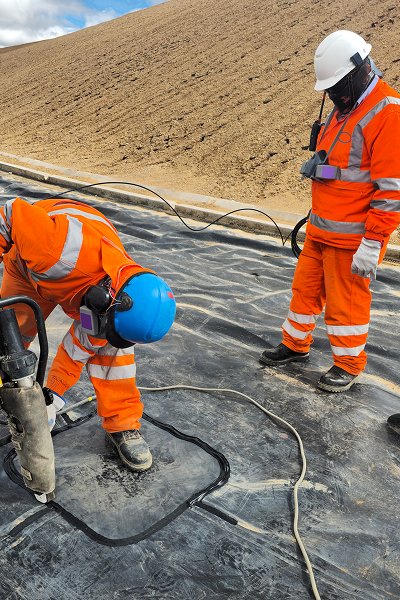What are GCL and Geomembrane ?
GCL, the full name of which is Geosynthetic Clay Liner, is a composite anti-seepage material formed by natural sodium-based bentonite sandwiched between two layers of geotextiles (usually non-woven fabrics and woven fabrics) and reinforced by needle punching and/or bonding processes. When exposed to water, bentonite will rapidly expand to form a low-permeability gel barrier that prevents water from passing through.

Geomembrane is an anti-seepage film made of polymer materials (such as HDPE, LDPE, LLDPE, PVC, etc.) with extremely low water permeability. It is usually manufactured by calendering or extrusion process, with thickness ranging from 0.3mm to 3.0mm.

Performance comparison analysis
Anti-seepage performance
GCL: Bentonite swells when exposed to water to form a gel-like barrier, and its permeability coefficient is generally 10⁻⁹~10⁻¹¹ m/s. If damaged or cracked, its anti-seepage performance will decrease.
Geomembrane: A physical barrier with a permeability coefficient as low as 10⁻¹³ m/s, which is much lower than GCL and is more suitable for projects that require extremely high anti-seepage effects.
Chemical corrosion resistance
GCL: Sensitive to strong acid, alkali or high concentration of salt, the performance of bentonite will deteriorate, and polymer modification is required.
Geomembrane: HDPE membrane has strong chemical corrosion resistance and can resist erosion by acid, alkali, salt and other substances for a long time
Adaptability to deformation
GCL: has a certain self-healing ability, and small cracks can be automatically repaired by the expansion of bentonite.
Geomembrane: has strong ductility, and LLDPE membrane is more flexible, but once punctured, the anti-seepage performance is lost.
Service life
GCL: The service life depends on the ambient humidity, dry-wet alternation frequency and chemical influence, and can generally reach more than 50 years.
Geomembrane: HDPE membrane can be used for 50-100 years and requires a protective layer for protection in ultraviolet exposure environments.
Construction comparison
Ease of construction
GCL: Just unfold the roll and overlap more than 30cm at the joint. The requirements for the base surface are relatively loose.
Geomembrane: Hot welding is required, and the quality control requirements for the welds are high, requiring professional equipment and personnel.
Conformity to the foundation surface
GCL: Can adapt to certain terrain undulations, especially suitable for slopes.
Geomembrane: Limited flexibility, requires a flat foundation surface, and poor conformity when encountering complex terrain.
Climate adaptability
GCL: It expands when exposed to water, so it is necessary to pay attention to waterproofing during rainy seasons. It is easy to dry out and become ineffective after construction in arid areas.
Geomembrane: It is easy to expand and contract in high temperatures in summer, and there is a risk of brittle cracking during construction in winter.
Engineering Application Scenarios Comparison
| Application Scenario | Recommended Material | Reason |
|---|---|---|
| Landfills | Geomembrane + GCL composite | High impermeability requirements; dual-layer protection |
| Artificial lakes / Landscape ponds | GCL or GCL + Geomembrane | Adapts well to terrain; more cost-effective |
| Reservoirs / Canals | Geomembrane | Extremely low permeability; long service life |
| Subways / Tunnels | GCL | Good adaptability to deformation; easy and quick installation |
| Chemical ponds / Tailings dams | Geomembrane | Excellent chemical resistance and durability |
Choose Based on Project Type and Purpose
| Project Type | Recommended Material | Reason |
|---|---|---|
| Landfills | GCL + HDPE Geomembrane | Dual-layer system offers high impermeability and chemical resistance |
| Artificial lakes / Wetlands | GCL or GCL + Membrane | Flexible to terrain, eco-friendly, cost-effective |
| Reservoirs / Channels | HDPE or LLDPE Geomembrane | Ultra-low permeability, long-term water retention |
| Subways / Underground Works | GCL | High adaptability to deformation and self-sealing capability |
| Chemical Ponds / Tailings Dams | HDPE Geomembrane (thick) | Excellent chemical resistance and mechanical strength |
| Road/Railway Soft Subgrade | GCL | Offers both sealing and soil reinforcement |
Consider Environmental Conditions
| Environmental Factor | Recommended Material | Reason |
|---|---|---|
| High chemical exposure | HDPE Geomembrane | Outstanding chemical resistance |
| Irregular or uneven terrain | GCL | Better conformity and flexibility |
| Frequent wet-dry cycles | Composite: Geomembrane + GCL | Prevents desiccation and improves reliability |
| High groundwater levels | Geomembrane | Strong and long-lasting water barrier |
Balance Budget and Long-Term Performance
| Comparison Point | GCL | Geomembrane (HDPE) |
|---|---|---|
| Material cost | Generally lower | Higher (varies by thickness) |
| Installation cost | Lower | Requires skilled welders |
| Long-term stability | Good but environmentally sensitive | Excellent; superior durability |
| Overall cost-efficiency | High for standard projects | Preferred for high-risk applications |


